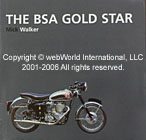Hardcover: 260 pages
Dimensions (inches): 8-5/8 x 8-3/8 x 7/8
Publisher: Redline Books, Tyne & Wear, UK 2004
ISBN: 0954435737
[includes/alibris/alibris-wbw-text.htm]
We’ve been slightly critical of the fecundity of Mick Walker’s genius for turning out scads of motorcycle books. It just seems that a few too many of the books were put together very quickly to capitalize on a new trend, with stock photos and text that seem more like filler than as something that provides unique insight.
Maybe it’s the fault of Walker’s editors or publishers or maybe we’re being just a bit too fussy. Or maybe with 100+ books to his name there’s simply bound to be a few duds here and there. I recently counted Mick Walker books in a bibliography and got too tired to continue after I reached 85. One thing’s for sure — he’s prolific.
That’s also not to say that his books aren’t enlightening, because they are. And sometimes there’s no other choice — if you want to know everything there is to learn about, for example, some obscure bike like the AJS 7R, only Mick can be your guide.
So in that regard, Mick Walker has been the motorcyclist’s historian of record for many years. And every once and a while, I’ll find another Mick Walker book that is truly a gem, like this incredible documentary of The BSA Gold Star.
Motorcycling has such a rich and varied history and it’s a real shame when, as I often witness, young motorcyclists either don’t know or don’t care about how we got to where we are today. Incredible rides like the Suzuki GSX-R1000, the Kawasaki ZX-14 or the Triumph Speed Triple didn’t just appear out of thin air. They have a long history of painstaking design and development behind them that, when taken step by step, has allowed them to come into being.
And many of today’s wonderful machines are indebted to the BSA Gold Star. This bike, which was released in its initial form in 1938, was sold in one form or another for the next 25 years. The “Goldie”, in its various forms, excelled for road work, trials, scrambling (now called Motocross) and racing.
The Gold Star was the definitive “Café Racer” of the 1960’s and became an icon in Europe and the United States. Walker tells the story of what happened when BSA, who was somewhat embarrassed by the rebellious crowd who popularized the bike, announced that production of that model was ending. The bike was so popular that BSA’s U.S. dealer network promptly refused to stock any of the other BSA models unless the Gold Star was included in the product mix!
My familiarity with the bike came not as an owner but as an admirer. It always seemed too raw and brutal for me, especially in the tooth-rattling 500cc versions that were more common in my youth. Walker makes a good case for the earlier 350cc models as the definitive Gold Star, which also made better racing bikes.
The book’s nearly square format, heavyweight calendar-type paper, hard cover binding and decent cover make it a great coffee table book for smaller homes. But although it’s loaded with good quality photos in both black and white and color, it’s also packed with tons of information on this very interesting and important motorcycle.
From the history of BSA and their early models through the Clubmans, Scrambles, Thruxton, Trials and more, Walker demonstrates that when he has the time and the passion, he can score aces. Even if you don’t know a Gold Star from an Empire Star, if you love motorcycles and their history, you’ll probably enjoy this book.
wBW Rating:
![]()
![]()
![]()
![]()
![]()
![]()
![]()
![]()
The wBW “Flaming Helmet” Book Review Rating System | Book Reviews Home | All Reviews, Sorted by their Flaming Helmet Rating



